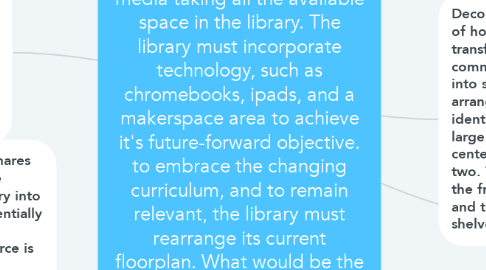Problem: An Elementary school library would like to begin advancing into a future foward entity, but the library currently has limited space due to an over abundance of books and other forms of media taking all the available space in the library. The library must incorporate technology, such as chromebooks, ipads, and a makerspace area to achieve it's future-forward objective. to embrace the changing curriculum, and to remain relevant, the library must rearrange its current floorplan. What would be the best arrangement of both technology and books to achieve the future-ready objective?
by Adrienne RosePearson

1. Pattern Recognition: According to Shoeneck and Nelson (2015), in order for libraries to become future-ready entities, they must embrace the trend in education that is geared to a reliance on technology, and comfortable learning spaces that promote collaboration.
1.1. Rationale: This is an example of pattern recognition because it statement recognizes trends and how the ideas are related.
2. Abstraction: Carr (2017), shares how the reason behind the transformation of the library into a learning commons is essentially critical to student success because the global workforce is requiring an increasingly analytical skill set that employees must have. As this need increases, it will be more critical for librarians to teach these skills, in an environment that is conducive to the teaching and learning process.
2.1. Rationale: This is an example of abstraction because it provides insight into why libraries and librarians must be future ready. As the marketplace changes, so must the curriculum and instruction in the library.
3. Algorithm: To transform the library into a learning commons, first the librarian must conduct a needs analysis to determine the deficiencies in supplies needed to make the transition. Next, the librarian must assess the space available, and determine what can be removed to accommodate the new areas of collaboration and research. Next, the librarian must evaluate the available technology, and determine funding sources to acquire more.
3.1. Rationale: This is an example of an algorithm because it offers step by step instructions to help the library and librarian achieve the objective of transforming the library into a future ready entity.
4. Decomposition: First, the problem of how to rearrange the library to transform it into the a learning commons must be broken down into smaller parts. The current arrangement must be assessed and identified. Currently, the library is a large rectangular space with a center pole that splits the room in two. There is a circulation desk a the front of the room by the office, and there are approximately 20 shelves that line the walls.
5. Rationale: This is an example of a decomposition according to Google Computational Thinking for Educators (n.d.), because it takes a larger problem and breaks it down into smaller, more manageable parts. The decomposition breaks down the parts of the library, making it easier to transform one part of the library at a time.
6. References: Carr, S. (2017). Teaching 21st Century Skills in the Library. Google Computational Thinking for Educators. (n.d.). What is Computational Thinking? Nelson, j. & Shoeneck, A. (2015). Planning for the Future of K-12 Libraries.



